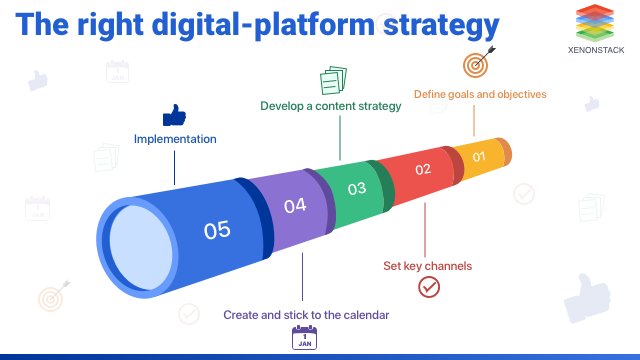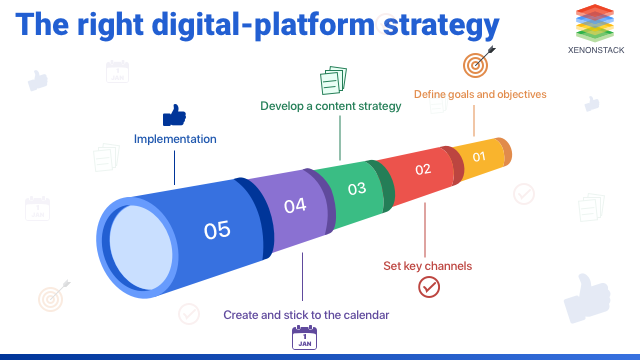Digital Platform Strategy is a comprehensive plan that outlines how businesses leverage digital platforms to achieve their goals. It involves developing strategies for online presence, customer engagement, and data analysis to drive growth and competitive advantage.
By utilizing various digital platforms such as websites, social media, mobile apps, and e-commerce channels, businesses can effectively reach their target audience, enhance customer experience, and optimize their operations. This strategy encompasses elements like content creation, search engine optimization, digital advertising, and data-driven decision-making.
With the increasing importance of digitalization, having a well-defined digital platform strategy has become vital for businesses to stay relevant and thrive in the digital age.
Credit: www.xenonstack.com
The Rise Of Digital Platforms
In today’s digital age, the rise of digital platforms has revolutionized the way businesses operate. With the increasing connectivity and technology advancements, digital platforms have become the cornerstone of modern business strategies. This shift has led to a remarkable transformation in the way companies engage with their customers, collaborate with partners, and create value in the digital ecosystem.
Era Of Connectivity
The era of connectivity has ushered in a new wave of opportunities for businesses to leverage digital platforms for reaching global audiences, delivering personalized experiences, and driving innovation. With the proliferation of mobile devices and the internet, the interconnectedness of people, devices, and data has created a fertile ground for digital platforms to thrive.
Case Studies: Giants Who Lead The Way
When it comes to digital platform strategy, several industry giants have set the benchmark for success through their innovative approaches. Companies like Amazon, Google, and Apple have demonstrated how digital platforms can be harnessed to create ecosystems that offer seamless experiences, diverse services, and unmatched convenience to users.

Credit: www.xenonstack.com
Key Elements Of A Digital Platform Strategy
Crafting a successful digital platform strategy involves integrating key elements like user experience design, data analytics, and scalability. By focusing on these components, businesses can enhance customer engagement, drive innovation, and achieve sustainable growth in the digital landscape.
Key Elements of a Digital Platform Strategy Creating a digital platform strategy is crucial for businesses to stay relevant in today’s digital age. A digital platform strategy enables businesses to create and capture value, build network effects, and develop ecosystems that drive growth. Let’s explore the key elements of a digital platform strategy. Value Creation and Capture Value creation and capture are essential components of a digital platform strategy. To create value, businesses need to understand their target audience and identify their pain points. Once these pain points are identified, businesses can create digital products and services that solve these problems. To capture value, businesses need to identify their revenue streams. These revenue streams can be generated through subscriptions, transaction fees, advertising, or data monetization. By creating and capturing value, businesses can generate sustainable revenue streams that drive growth.
Designing A Platform For Success
Designing a Platform for Success is crucial in today’s digital landscape. To stand out and thrive, businesses must prioritize User Experience and Data-Driven Decision Making.
User Experience As A Priority
Ensuring a seamless and intuitive user interface.
- Optimizing for mobile responsiveness.
- Personalizing user interactions.
Data-driven Decision Making
Utilizing analytics to drive strategic choices.
- Collecting and analyzing user data.
- Implementing feedback loops for continuous improvement.
Credit: www.youtube.com
Monetization Models For Digital Platforms
When it comes to digital platforms, finding the right monetization model is crucial for sustainable growth and profitability. Digital platforms have revolutionized the way we consume content, products, and services, opening up new opportunities for businesses to generate revenue. In this section, we will explore two popular monetization models for digital platforms: subscription services and freemium models with advertising.
Subscription Services
Subscription services have gained immense popularity in the digital era, offering users access to exclusive content or features in exchange for a recurring fee. This model provides a steady stream of revenue for digital platforms while ensuring a high-quality experience for subscribers. By offering different subscription tiers, platforms can cater to various user needs and budgets. Here are some key advantages of subscription services:
- Steady and predictable revenue stream
- Opportunity to offer premium content or features
- Ability to build a loyal customer base
- Potential for higher customer lifetime value
However, it is essential to strike a balance between providing enough value to justify the subscription cost and avoiding alienating potential users with excessive fees. Offering a free trial or a freemium version can help attract users and showcase the value of the subscription.
Freemium Models And Advertising
Freemium models combine free access to basic features or content with the option to upgrade to a premium version for enhanced functionality or an ad-free experience. This model allows digital platforms to attract a large user base while generating revenue through advertisements or premium upgrades. Here are some advantages of freemium models:
- Wide user adoption due to the free access
- Opportunity to upsell premium features
- Potential for increased advertising revenue
- Ability to gather valuable user data
By offering a free version, digital platforms can gain traction and establish a user base, which can then be monetized through advertising or premium upgrades. However, it is crucial to strike a balance between offering enough value in the free version to attract users and providing compelling incentives to upgrade to the premium version. Overall, the choice of monetization model for a digital platform depends on various factors such as target audience, content or service offering, and competitive landscape. Subscription services and freemium models with advertising are just two examples of the many monetization strategies available. Each platform must carefully evaluate its unique requirements and goals to determine the most suitable approach.
Building A Robust User Base
Building a Robust User Base is vital for the success of any digital platform strategy. A strong user base provides the foundation for sustainable growth and long-term success. By focusing on acquisition tactics and retention strategies, digital platforms can effectively expand their user base and ensure continued engagement and loyalty.
Acquisition Tactics
Acquisition tactics play a crucial role in building a robust user base. Leveraging targeted advertising, social media marketing, and search engine optimization can effectively attract new users. Additionally, partnerships and collaborations with influencers and industry leaders can expand the platform’s reach and attract a diverse user base. Offering incentives such as discounts, free trials, or exclusive content can also entice new users to join the platform.
Retention Strategies
Retaining existing users is equally important for building a robust user base. Providing personalized recommendations and a seamless user experience can enhance user satisfaction and encourage continued engagement. Reward programs and loyalty incentives can also foster a sense of belonging and encourage users to remain active on the platform. Moreover, regularly seeking user feedback and implementing updates based on user preferences can demonstrate a commitment to meeting the needs of the user base.
Leveraging Artificial Intelligence
Artificial Intelligence (AI) is revolutionizing the way businesses operate in the digital landscape. Leveraging AI technologies can enable organizations to enhance their digital platform strategies, driving innovation, and creating competitive advantages.
Personalization Engines
AI-powered personalization engines are essential for delivering tailored experiences to users. By analyzing user data, AI can create personalized recommendations and content, improving user engagement and satisfaction.
Operational Efficiency
AI can streamline operations through automation and predictive analytics, optimizing processes and reducing costs. By leveraging AI, businesses can make data-driven decisions and improve overall operational efficiency.
Navigating Regulatory Challenges
As businesses expand their digital presence, navigating regulatory challenges becomes crucial to ensure compliance and sustainability.
Data Privacy And Security
Protect customer data from breaches by implementing robust security measures.
Compliance Across Borders
Adhere to varying regulations in different countries to avoid legal complications.
Future Trends In Digital Platform Markets
As technology continues to advance, the future trends in digital platform markets are evolving rapidly.
Blockchain Applications
Blockchain technology is revolutionizing digital platforms by ensuring secure and transparent transactions.
The Role Of Virtual Reality
Virtual Reality is reshaping digital platforms by providing immersive user experiences.
Frequently Asked Questions
What Are The Three Strategies To Launch A Digital Platform?
Three strategies for launching a digital platform include defining goals clearly, understanding target audience, and leveraging social media.
What Is Platform Strategy In Digital Marketing?
Platform strategy in digital marketing involves choosing the right online channels to reach target audiences. It focuses on utilizing platforms like social media, search engines, and websites for effective marketing and customer engagement. This strategy helps businesses optimize their online presence and drive better results.
What Are The 4 Digital Platforms?
The four digital platforms are: 1. Social media 2. Search engines 3. Websites 4. Mobile apps
What Are The 5 Rules Of Digital Strategy?
The 5 rules of digital strategy are: 1. Keep sentences brief, with a maximum of 20 words each. 2. Write in a SEO friendly, human-like, unique, and plagiarism-free manner. Use active voice and make it easy to understand. 3. Avoid starting sentences with certain words and phrases, and don’t write in passive voice.
4. Pass AI writing detection and write like a human. 5. Answer within 50 words.
Conclusion
To sum up, a well-executed digital platform strategy is crucial for any business looking to thrive in the digital age. By leveraging the power of digital platforms, businesses can tap into new markets, engage with customers more effectively and streamline their operations.
However, it is important to remember that building a successful platform requires a careful and strategic approach, as well as a deep understanding of the needs and preferences of your target audience. By following the guidelines outlined in this post, you can create a platform that delivers real value to your customers and drives long-term growth for your business.
